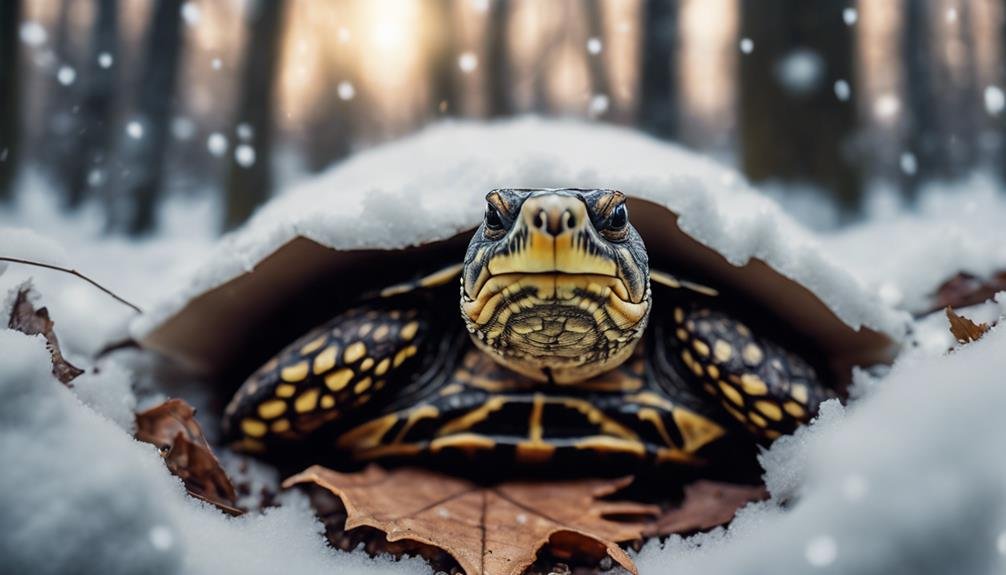You might think box turtles hibernate, but they actually undergo a fascinating process known as brumation. This reptile-specific dormancy isn’t just a deep sleep; it’s a complex preparation for the colder months. Box turtles reduce their food intake and adjust their body temperature, readying themselves for a period of minimal activity. They dig into the earth, creating burrows to shelter from the harsh weather. What’s intriguing is the metabolic shift that occurs, allowing them to conserve energy when resources are scarce. But how exactly do they manage to lower their metabolic and heart rates, and what can we learn from their survival mechanisms? This glimpse into their world is just the beginning of understanding their unique adaptation to nature’s cycles.
Key Takeaways
- Box turtles enter brumation, not hibernation, to conserve energy during winter.
- They prepare by reducing food intake and adjusting their body temperature.
- During brumation, their metabolic rate decreases, conserving vital energy.
- Turtles use burrowing techniques to create insulated shelters below the frost line.
- Emergence from brumation is triggered by soil temperatures around 50 degrees Fahrenheit.
Understanding Brumation
Brumation is an important dormancy period for reptiles like box turtles, greatly slowing their metabolic activities to survive the cold months. This natural process allows them to conserve energy when food is scarce, adjusting their body temperature to match their chilly surroundings. As temperatures drop in late fall or early winter, box turtles instinctively know it’s time to prepare for brumation. They begin by reducing their food intake, since a lower metabolic rate means their bodies can’t process food as efficiently.
During this period, box turtles dig themselves into burrows below the frost line, seeking stable temperatures and insulation against the cold. This clever strategy secures their survival, as the stable burrow environment allows them to maintain a body temperature that’s consistent with the earth around them, avoiding the harsher conditions above ground. By aligning their body temperature with their environment, box turtles can conserve the essential resources they need to make it through the winter.
Brumation is therefore critical for their survival, enabling these resilient creatures to emerge in the spring ready to resume their active lives.
Box Turtle Behavior
Understanding how box turtles prepare for winter leads us naturally to explore their distinctive behaviors, particularly their unique burrowing habits. Their burrowing behavior isn’t just an essential; it’s a sophisticated survival strategy. You’ll find that box turtles are quite the engineers when it comes to creating insulated shelters for brumation. They use their robust forelimbs and hind legs to meticulously dig tunnels and cozy hollows. This isn’t just about finding a place to sleep; it’s about survival.
The burrows they craft are more than just holes in the ground; they’re custom shelters designed to shield them from freezing temperatures and environmental stresses. These underground hideaways provide crucial protection from the cold and the lack of food during the winter dormancy period. It’s fascinating to see how this behavior helps box turtles conserve energy and endure food scarcity. They’re not just surviving through the winter; they’re employing a well-honed strategy that has ensured their survival through countless winters. Their burrowing behavior is a proof of their adaptability and resilience, important traits for brumation.
Preparing for Dormancy
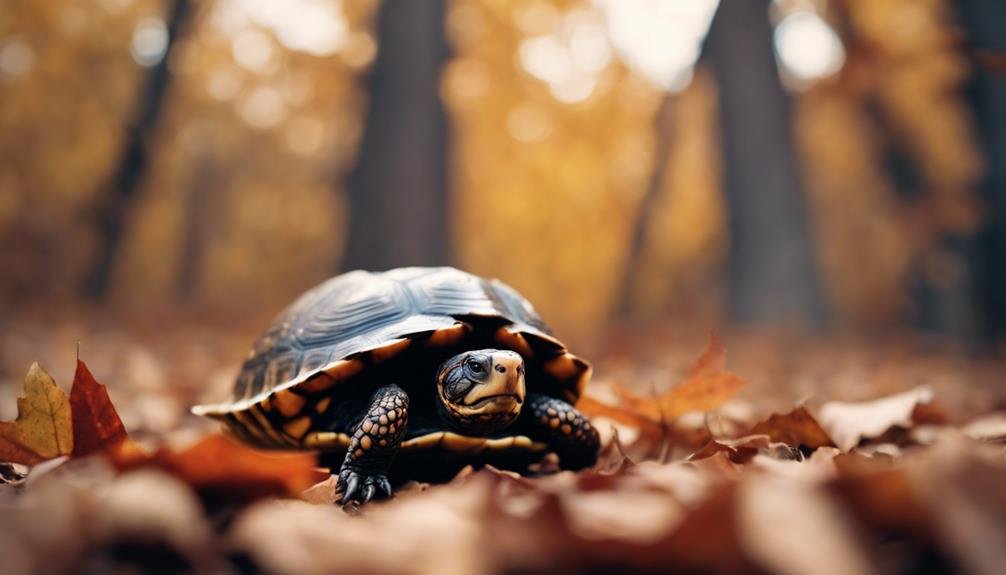

As temperatures drop, you’ll notice your box turtle showing signs of brumation, signaling it’s time to prepare for dormancy.
You need to create a safe and comfortable environment that mimics their natural burrowing conditions to safeguard their health and safety during this period.
Monitoring their behavior and health closely is vital to help them through this natural, yet vulnerable, phase of their life cycle.
Identifying Brumation Signs
You’ll notice your box turtle getting ready for brumation when the temperature drops in late fall or early winter, as they start their search for the perfect spot to spend the dormant period.
The cooler night temps trigger their instinct to burrow. They become impressive diggers, using their robust forelimbs to create tunnels deep enough to escape the frost, and their strong carapace plays a crucial role in shielding them from the chill.
These cozy hollows, crafted meticulously with their hind legs beneath leaf litter, in soils, or under logs, make sure they’re snug against freezing temperatures and scarce food supplies. This burrowing isn’t just about staying warm; it’s a clever strategy to avoid environmental stress, providing insulation and protection throughout the brumation process.
Creating a Suitable Environment
To guarantee your box turtle safely enters brumation, establishing a suitable environment that mimics their natural burrowing habitats is essential. As temperatures drop in late fall or early winter, box turtles prepare for dormancy. They showcase their digging prowess to create cozy hollows under leaf litter, in soils, or beneath logs, utilizing their robust forelimbs and hind legs. These spots offer insulation and protection from the cold, important for the brumation process.
| Environment Feature | Importance for Brumation |
|---|---|
| Leaf Litter | Provides insulation and cover |
| Soil or Beneath Logs | Allows for cozy burrowing |
| Temperature Control | Mimics natural cooling cues |
Creating these conditions helps shield box turtles from freezing temperatures and environmental stresses, ensuring they conserve essential resources to survive the winter.
Monitoring Health & Safety
Before your box turtle hibernates, it’s important to check their health and weight to make sure they’re ready for dormancy. Monitoring their condition before brumation means looking out for signs of illness such as lethargy or a lack of appetite. It’s also vital to have a reptile-savvy vet conduct a pre-brumation physical examination to confirm they’re fit for dormancy.
Once they’re in brumation, expect a normal weight loss of about 6-7% of their body weight. During this period, you’ll need to regularly soak, weigh, and monitor your box turtle to ensure their health and safety. This care during pre-brumation and brumation helps your turtle navigate dormancy safely and emerge healthy come spring.
The Burrowing Technique
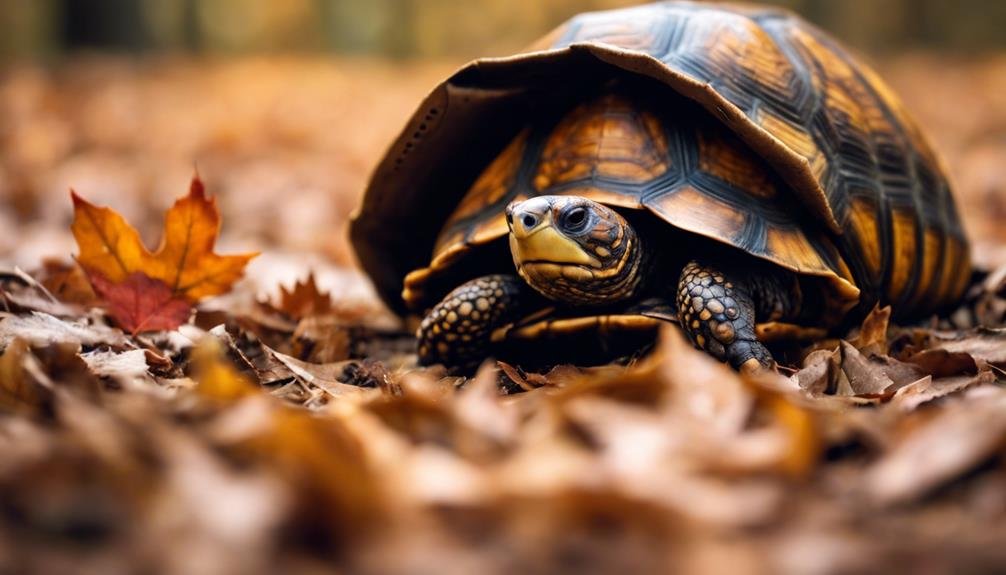

Box turtles expertly utilize their robust forelimbs to initiate the burrowing process, ensuring their survival during the colder months. These creatures are adept at digging tunnels, using their strength to reach depths below the frost line. This strategy allows them to access stable temperatures, critical for their dormancy period. As they dig, box turtles employ their hind legs and the strength of their carapace to create cozy hollows within these burrows. This meticulous process turns a simple dug-out tunnel into a comfortable haven, safeguarding them from the harsh winter environment.
Burrowing is more than just a means to avoid the cold; it’s a survival tactic that shields box turtles from freezing temperatures, helping them conserve essential energy throughout the winter. By retreating into the earth, they’re not only evading the chill but also protecting themselves from environmental stresses that could jeopardize their brumation period. The burrow becomes a sanctuary, a place of rest and rejuvenation for these turtles as they wait out the winter, ready to emerge with the warmth of spring. This burrowing technique is a reflection of the resilience and adaptability of the box turtle, ensuring its survival in the face of seasonal challenges.
Metabolic Changes
As winter approaches, box turtles undergo a notable reduction in their metabolic rate, essential for their survival during the colder months. This process, known as brumation, is a fascinating adaptation that allows these creatures to conserve energy when food is scarce and temperatures drop. Unlike hibernation, which is a deep sleep, brumation is a period of dormancy where box turtles’ metabolic rate, heart rate, and other bodily functions slow down significantly.
During brumation, box turtles’ body temperature aligns with their surroundings. This adaptation minimizes energy expenditure, allowing them to survive on their stored reserves. The slowed metabolic rate is vital for enduring the winter months without the need for frequent feeding.
Here’s a quick overview of the metabolic changes in box turtles during brumation:
| Aspect | Change During Brumation |
|---|---|
| Metabolic Rate | Markedly decreases |
| Energy Conservation | Maximizes by reducing metabolism |
| Body Temperature | Aligns with the environment |
| Bodily Functions | Slows down to conserve energy |
| Adaptation | Helps survive winter and food scarcity |
Understanding these metabolic changes highlights how box turtles are remarkably adapted to thrive in diverse environments, showcasing the intricacies of their survival strategies.
Temperature and Heart Rate
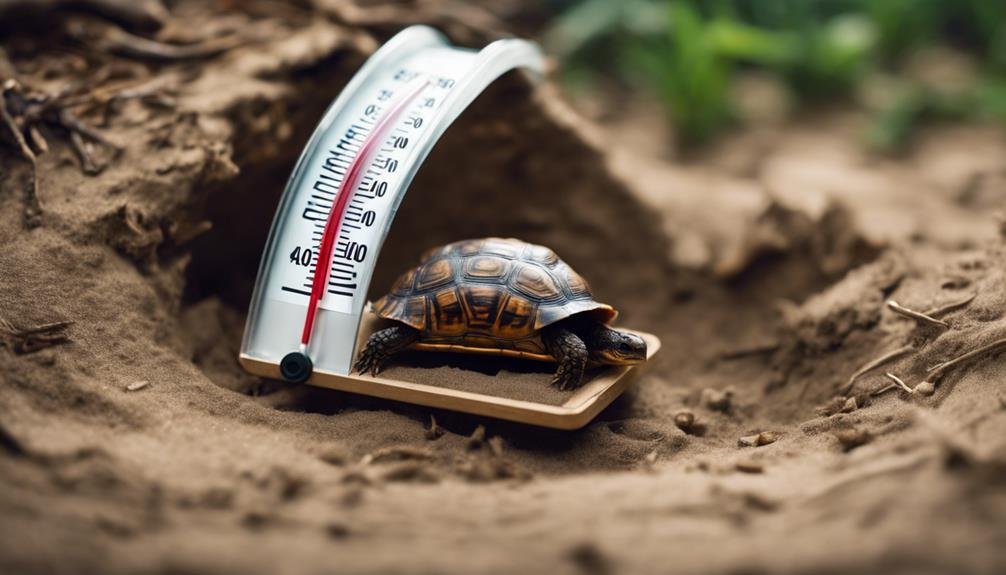

During brumation, a box turtle’s heart rate markedly drops as a response to the cooler temperatures, conserving much-needed energy. This significant decrease in heart rate is an important part of the turtle brumation process, allowing these reptiles to survive periods of cold without the need for frequent activity or feeding. As the temperature dips, your box turtle’s body instinctively knows it’s time to slow down, aligning its heart rate with the chilly surroundings to minimize its metabolic rate.
This metabolic slowdown is directly tied to the decrease in heart rate. By reducing their heart rate, box turtles effectively lower their energy needs. This conservation strategy is crucial for surviving the cold months when food is scarce, and the environment is less hospitable. The heart rate of box turtles during this period doesn’t just slightly decrease; it plummets, showcasing the drastic measures these creatures take to endure brumation.
Understanding this link between temperature and heart rate is important if you’re caring for a box turtle. Recognizing the signs of brumation can help you provide the right environment for your pet to safely undergo this natural process without undue stress or health complications.
Survival Mechanisms
Understanding how the heart rate and temperature of box turtles decrease is just the beginning; let’s now explore the survival mechanisms these remarkable creatures use to thrive through brumation. As you dive deeper, you’ll find that box turtles lower their metabolic rate during this period. This isn’t just an important adaptation; it’s a key adjustment that allows them to conserve energy when food is scarce and temperatures drop. They’re not just sitting idle; they’re strategically slowing down to make the most of their reserves.
But how do they sustain themselves without active feeding? Box turtles have a clever strategy for that. Before brumation kicks in, they stockpile glycogen, a form of stored glucose, which serves as their energy source while they’re dormant. It’s like filling up a car’s gas tank before a long journey. This stored energy is essential for their survival through the colder months.
Moreover, the burrows they create are more than just holes in the ground; they’re carefully constructed microclimates. These burrows provide warmth, staying above freezing temperatures thanks to soil insulation. This ingenious use of their environment ensures that box turtles maintain survivable temperatures during the harsh conditions of brumation. Their adaptations and resilience are truly what enable them to survive in diverse environmental conditions.
Emerging From Brumation
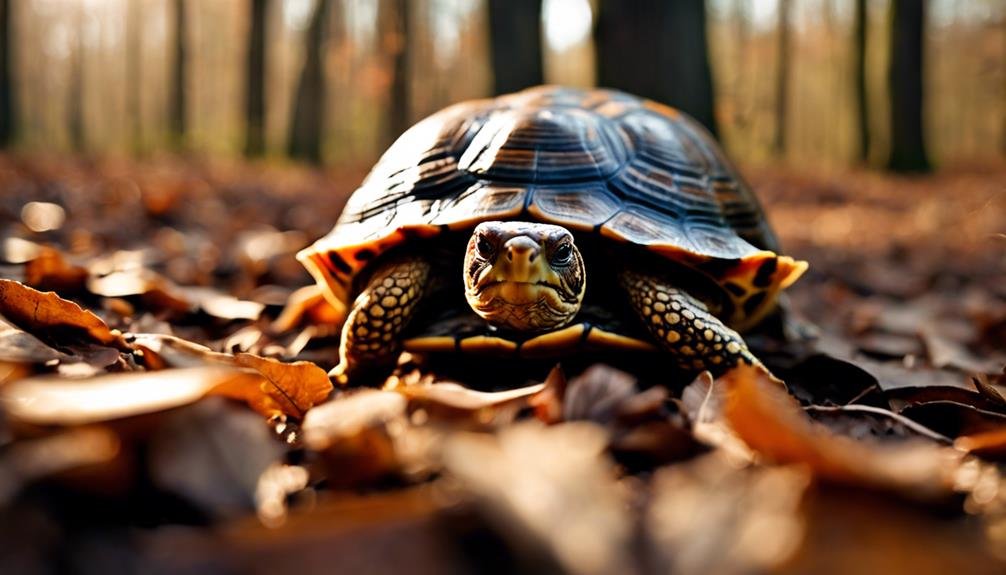

When soil temperatures hit around 50 degrees Fahrenheit, box turtles start to emerge from brumation. This process is deeply tied to the environmental cues, particularly the warmth of the soil. As the earth around their burrows begins to warm up with the arrival of spring, these turtles instinctively know it’s time to wake up. It’s fascinating how closely their emergence is linked to these soil temperature cues.
Monitoring these temperatures is key to understanding when box turtles will make their appearance. Studies have consistently shown that this period typically falls in spring, aligning perfectly with the ideal conditions for their return to activity.
Here’s a quick glance at how soil temperatures influence their emergence:
| Aspect | Detail | Importance |
|---|---|---|
| Soil Temperature | Around 50 degrees Fahrenheit | Trigger for emergence |
| Season | Spring | Ideal conditions |
| Behavior | Turtles emerge to find food and mates | Survival and reproduction |
As you keep an eye on the soil temperatures in your area, you’ll be better equipped to predict when these fascinating creatures will start emerging from brumation. It’s a clear sign that nature is waking up, with box turtles among the first to step into the spring sun.
Conservation and Impact
Common box turtles, now classified as vulnerable, face growing threats from habitat destruction and road development, urging immediate conservation efforts. As a species of box turtle, their declining populations have caught the attention of conservationists worldwide, leading to their listing on the IUCN Red List and Appendix II of CITES. This status isn’t just a label; it’s a call to action to prevent their exploitation and guarantee their survival.
You’re directly impacted by these efforts. Conservation measures, including habitat protection and population monitoring, are critical steps in safeguarding the future of box turtles. But, it’s not just about setting aside land or tracking numbers. Extensive research into their habits, needs, and threats is essential for informed conservation strategies. Additionally, community involvement plays a pivotal role. By understanding and participating in the conservation of this species of box turtle, you’re contributing to a larger movement aimed at preserving biodiversity.
Frequently Asked Questions
How Do You Know if Your Box Turtle Is in Brumation?
You can tell if your box turtle is in brumation by observing a few key signs.
They’ll show less interest in food and exploration, becoming less responsive overall.
You might notice them seeking out dark, secluded spots to remain motionless for long periods.
Their body temperature may drop slightly due to a slower metabolism.
Monitoring their weight loss and changes in behavior will also help you confirm if they’re entering or already in brumation.
How Do Box Turtles Brumate?
You’re curious about how box turtles brumate, right?
Well, as temperatures drop, they instinctively know it’s time to slow down. They’ll start digging using their strong limbs to create a snug burrow below the frost line, where it’s safe and warm.
In this cozy spot, their metabolic rate plummets, allowing them to conserve energy while their body temperature matches the chilly surroundings. It’s their natural way to weather the cold months.
How Long Is the Brumation Period for Turtles?
You’re wondering about the length of the brumation period for turtles, right?
Well, typically, it stretches from late fall or early winter through to early spring. This duration can shift a bit depending on their local environment and the specific conditions there.
During this time, box turtles really dial down their metabolism to save energy, which helps them get through winter by using less energy and coping with less available food.
How Do You Wake up a Turtle From Brumation?
To wake your turtle from brumation, you’ll need to gradually increase the surrounding temperature, mimicking natural warming.
Gently expose them to more light, simulating the longer days of spring.
Offer water and a bit of food to coax them back to activity.
Remember, sudden changes are a no-go; they can stress your turtle out.
Keep a close eye on them for any signs they’re ready to fully wake up.
Conclusion
In essence, you’ve learned that box turtles don’t hibernate but brumate, preparing for winter by reducing food intake, aligning their body temperature with the environment, and creating burrows. This process involves significant metabolic adjustments, including decreased metabolic and heart rates, to conserve energy.
It’s a vital mechanism allowing them to emerge in spring, ready for reproduction. Understanding and supporting these natural behaviors is essential for their conservation and the impact on their populations.

